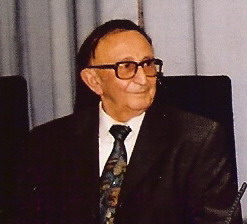
Dr. Heshmatollah Kermanshahchi was born in 1926 into a devoted Jewish family in Kermanshah, Iran. He was the son of Ebrahim Kermanshahchi, a prosperous merchant known for his trade with other countries and the founder of the Hadash synagogue and the first Jewish cemetery of Kermanshah,.
The family migrated to Tehran in 1936, where Heshmatollah went to Alliance Elementary School and the American College of Tehran. He completed his school studies at sixteen and immediately participated in the university entrance exam. He was admitted to Tehran University to study Pharmacology. By 19, he had completed the course and acquired his “Doctor of Pharmacy” degree, along with several awards and medals in recognition of his accomplishments during his study. In 1949, he married Behiya from the Kashefi family. They had three daughters and a son.
Dr. Heshmatollah Kermanshahchi never stopped studying. He participated in various workshops and study-from-home courses, even up to the age of 62. He obtained degrees and certificates on Commercial Law, Managerial Economics, Trade, and Political Sciences offered by such universities as New York University, Michigan University, and UCLA. He spoke English, French, and German fluently.
The year 1940 marked Dr. Heshmatollah Kermanshahchi’s first social activity, he established the Literary Society at Alliance School. He moved on to found the Youths Association afterward. Later, with help from his friends, he founded a gym for Jewish men called “Brothers Gym”, a first for the Jewish religious minority of Iran. The gym was dedicated to Pahlevani and Zoorkhone exercises, which is traditional Persian martial art. The gym became the center for Jewish youths of Tehran to gather and engage in cultural activities. In 1944, with the help of the members of the Brothers Gym, the Sisters Gym was established. The Sisters Gym led to the founding of the Iranian Jewish Womens Organization, another first for the community.
In 1955, Dr. Heshmatollah Kermanshahchi became an official member of the Tehran Jewish Committee. This coincided with reformations within the committee in regards to how it is managed and organized. The reformations demanded that the Chairman be elected by free and fair elections, rather than being selected as was previously customary. This led to contentions within the Jewish community. The issue was finally resolved by Ebrahim More, Musa Kermanian, Heshmatollah Kermanshahchi, Mozaffar Mosanen, Dr. Loghman Amini, Jahangir Banayan, and Yuosef Kohn—who were charitable members of the Committee—and Haj Habib Elghanian won the vote to Chair the Committee.
Dr. Kermanshahchi represented the Jewish community and their enterprises in various international meetings and lectures. He and Musa Kermanian were the Committee’s delegates to the World Jewish Congress in Stockholm, Sweden, in 1959. He always took the initiative to promote Iran and introduce the Jewish community of Iran.
In 1962, Dr. Heshmatollah Kermanshahchi was asked to administrate the elections that the Committee had ahead. He used an advanced system to organize the administrative procedures of the Committee with the help of other members. The Jewish community and governmental organizations saw the new system as a reliable institution.
In 1966, he was asked to administrate the national treasury of the Jewish Committee. He spent five years participating in many meetings and carefully designing a foundation that could address the financial needs of the community and fund the culture and sanitation in a broad sense.
The foundation was eventually opened in 1971. It managed to serve the Jewish community extensively in the short few years it survived before the 1979 revolution in Iran. For instance, the treasury funded the community’s first retirement home and a youth center. It financed the reconstruction of the Kurosh schools, the Dr. Sapir Hospital, and founded many community centers.
Dr. Kermanshahchi had created a financial system that all social institutions would use, but his contributions weren’t limited to organizing the financial affairs of the community’s institutions. He modernized and organized the Iranian Jewish population, due to which the Jewish community became a unique group in the Iranian society and experienced greater stability.
In 1974, Dr. Kermanshahchi was elected as the secretary of the Tehran Jewish Committee. He was tirelessly committed to promoting the Iranian Jews. Dr. Kermanshahchi convinced many Jews to participate in social events and elections.
The Jewish Committee of Tehran emerged as an organized and united institution in the 1970s. It was influential and respected. The Committee solved many of the struggles the community faced through the changes of time, while maintaining their honor, and thus the Committee was perceived as a credible institution at the national and international level. After the 1979 revolution in Iran, Dr. Heshmatollah Kermanshahchi immigrated to the United States reluctantly, just like many other of his coreligionists. He left with his family and settled in Los Anglele. Soon, he reinitiated his social activities and established the Federation of Iranian Jews in Los Angeles in 1980. The federation became a considerable help the families that had migrated to this foreign land.
In 2007, he published a book titled, “The social transformation of the Jews in the 20th century”. The book is a collection of his memoirs. In addition, it reports his social contributions and hundreds of others who played a substantial role in the transformation of the community.
Although Dr. Heshmatollah Kermanshahchi is in retirement in Los Angeles these days, yet he remains an active member of the Jewish community.


 فارسی
فارسی